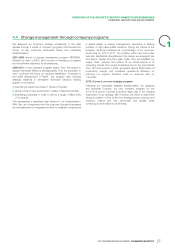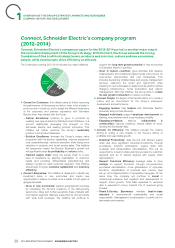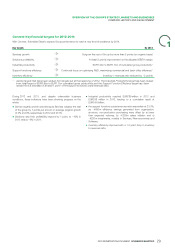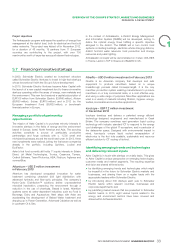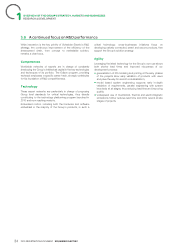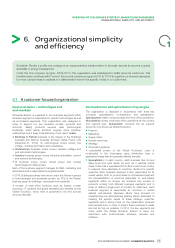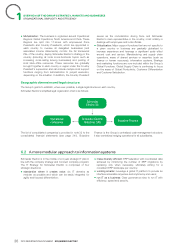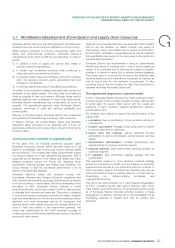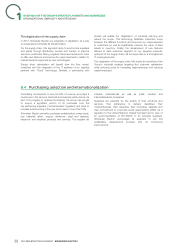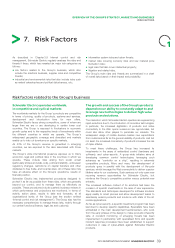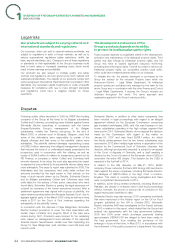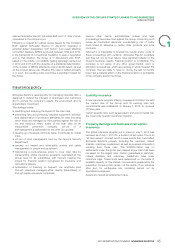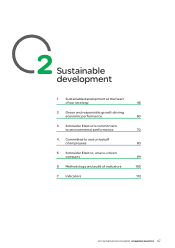APC 2013 Annual Report Download - page 39
Download and view the complete annual report
Please find page 39 of the 2013 APC annual report below. You can navigate through the pages in the report by either clicking on the pages listed below, or by using the keyword search tool below to find specific information within the annual report.
OVERVIEW OF THE GROUP'S STRATEGY, MARKETS AND BUSINESSES
ORGANIZATIONAL SIMPLICITY AND EFFICIENCY
Worldwide redeployment of production and supply chain resources
6.3
1
Schneider Electric has more than 250plants and 100distribution
Nearly all of our industrial sites have now been ISO14001 certified,
centers around the world Customer satisfaction is its top priority.
and so we can address our efforts towards new areas for
improvement, which were initiated and/or pursued in 2012–2013,
While working constantly to improve occupational health and
like ISO50001 certification (energy efficiency) as well as qualitative
safety and environmental protection, Schneider Electric’s
and quantitative improvement of our sites water consumption and
manufacturing policy aims to fulfill four key objectives, in order of
industrial waste generation.
priority:
Schneider Electric has implemented a policy to systematically
to achieve a level of quality and service that meets or1)
identify and reduce its industrial risk in order to secure maximum
exceeds customer expectations;
service to its customers and to minimize any impact of disaster,
to obtain cost competitive products while continuing to
2) whether it is internal in nature (fire) or external (natural disasters).
deliver strong and consistent productivity; This policy relies on local actions to remove the identified risks
to develop system speed and efficiency and limit production3) following audits led by an external firm recognized by insurers, as
sites’ risk exposure (currency parity, geopolitical risks and well an action plan for the continuity of production. If, after
changes incost factors); corrective actions the risk remains too high, then the activity is
to optimize capital employed in manufacturing operations.
4) repeated at another Schneider Electric site.
A number of the production facilities and distribution centers are
The segmented response to customer needs
dedicated to the global market. The other units are located as
close as possible to their end markets. Although design and/or In2012, Schneider Electric launched the “Tailored Supply Chain”
aesthetic features may be adapted to meet local requirements, program as part of the company program Connect, with the aim
SchneiderElectric standardizes key components as much as to better align the supply chain set-up with the needs and
possible. This global/local approach helps Schneider Electric behaviors of each customer segment (distributors, partners,
maximize economies of scale and optimize profitability and panel builders,etc.).
service quality. Six initiatives were defined to support the transformation of the
Drawing on its global scope, Schneider Electric has re-balanced supply chain:
and optimized its manufacturing and supply chain resources. purchasing: step up purchasing to drive proactive planning of
l
In Western Europe, the United States, Japan and Australia, procurement;
adaptation plans continued to be deployed with a focus on footprint optimization: manage critical component’s footprint
l
specializing production and supply chain units and reducing the to improve lead-time to customers;
number of sites. supply chain flow redesign: reduce lead-time through
l
Continuous improvement on a global scale
optimization of plant and distribution center footprint and flow
design;
transportation rationalization: increase partnerships with
l
At the same time, an industrial excellence program called selected carriers to improve customer service;
Schneider Production System (SPS) has been rolled out in all industrial planning: build best-in-class planning process by
l
plants to substantially and continuously improve service quality customer segment;
and productivity. The program also takes environmental criteria IT capability: align information systems strategy with this
l
into account. Based on a lean manufacturing approach, SPS is segmentation.
supported by the extension of Six Sigma and Quality and Value This approach required a more dynamic industrial strategy
Analysis programs across the Group. By deploying these around how we serve our clients, how to configure our products,
optimization methods globally and sharing best practices, the equipment and services for our customers and how to deliver to
Group intends to raise the operational performance of all its those customers, while at the same time, simplifying the way we
plants to the same high standard. work and therefore focus on creating value for our customers by
Schneider Electric’s plants and products comply with streamlining our decision-making processes and
increasingly extensive and stringent European regulations and organizationalstructure.
with international standards governing environmental protection This led to the announcement of a new Industrial Organization
in all host countries. In many cases, the Group anticipates future for2013, operating around eight regions (Europe, CIS, China,
standards. In1992, Schneider Electric defined a formal India, Pacific, Asia, North America, South America) which groups
environmental policy, which was revised in2004 to take account all of Schneider Electric Industrial activities together in these
of changes both internally and externally. This policy is designed geographies. In addition, this also led to the verticalization of all
to improve production processes, promote eco-design, integrate Purchasing activities to simplify and unify its contact with
customer expectations into the Group’s environmental protection Suppliers.
approach and raise awareness among all employees and
partners about environmental protection and energy efficiency. In
order to limit risks related to the environment generally, the
Group has implemented an ISO14001-compliant process to
continuously improve the environmental performance of its plants
and supply chain centers.
37
2013 REGISTRATION DOCUMENT SCHNEIDER ELECTRIC


